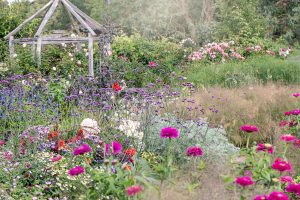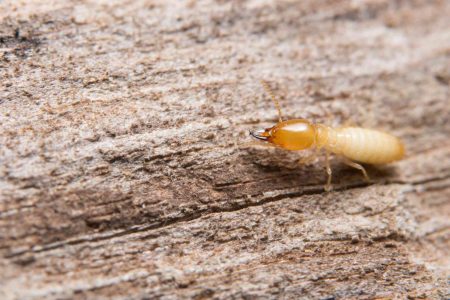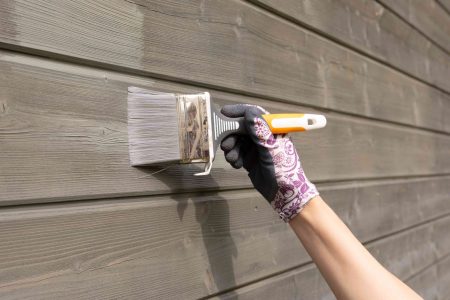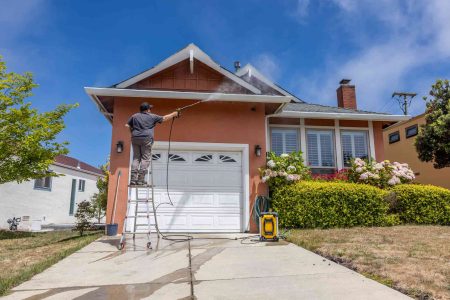Building a pallet planter is easy to do on your own. When flat, they look just like what they are: wooden platforms. But when set upright and turned backward, pallets can become vertical wall planters or raised garden beds deep enough to grow vegetables, herbs, trailing plants, flowers, and more. It can also be mounted as a fence pallet planter in your backyard.
Making a pallet planter is a fun, fast, and easy project that you can do with a pallet or two in just a couple of hours during the afternoon. Pallet planters typically last for three to six years. Not only that, pallet planters are a very affordable option compared to purchasing raised container garden planters.
This vertical pallet planter project gives you a wall of four planters to use. Follow our step-by-step guide to how to make a pallet planter to build your own.
Parts of a Pallet That Become a Planter
- Top Deck Boards: Pallets that are 48 inches by 40 inches usually have seven top deck boards and 30-inch by 30-inch pallets have five top deck boards. After conversion to a pallet planter, the top deck boards will form the planter’s front wall.
- Bottom Deck Boards: On the bottom are five deck boards for the larger 40-inch pallets and three deck boards for the smaller 30-inch pallets. As a pallet planter, the bottom deck boards will form the backs of individual planter boxes.
- Stringers: Stringers are the two-by-fours that run perpendicular to the top and bottom deck boards. There will be two side stringers and one center stringer. As a pallet planter, the stringers will form the sides of individual planter boxes.
What You’ll Need
Equipment / Tools
- Hammer
- Staple gun
- Sandpaper
- Tape measure
- Utility knife
- Gardening tools
- Paint brush/roller (optional)
- Drill (optional)
Materials
- 1 or 2 wood pallets
- Galvanized nails
- Landscape fabric
- Potting soil
- Plants
- Pea gravel or drainage rocks (optional)
- 2 one-by-sixes, each 8-foot (optional)
- Paint or other coating (optional)
- One-by-fours (as needed)
Instructions
How to Build a Pallet Planter
Warning
When finding a pallet to use, avoid chemically treated pallets, which can be toxic. These will be painted or have a stamp “HT” indicating that they’ve been treated with heat as opposed to chemicals.
-
Repair, Replace, or Remove Deck Boards
Repair or replace any missing or damaged top or bottom deck boards. You can use a second pallet to match the size, color, and texture. If you do not have a second pallet available for parts, use one-by-four lumber.
If the pallet has multiple boards close together on the top deck, remove some of them using the hammer to create space between slats, saving the wood you remove to be used later. We recommend removing every other slat, keeping the slat at the top and at the bottom.
-
Remove Nails
Using the hammer, remove any exposed nails from the removed slats and dispose of them.
-
Turn Pallet on Its Side
Turn the pallet vertically on one side, with the bottom deck boards facing you. Orient the pallet with the deck boards running horizontally (or parallel to the ground) and the stringers running parallel to you.
-
Add Interior Slats
Insert the boards you removed into the center of the pallet, lining up each board with a remaining slat on the top and placing the boards parallel to the ground. (These will form the bottoms of the boxes.) The slats should rest on the interior stringers.
Together, the top slat and the just-added board should form a sort of box shape. If necessary, you can use wood from another pallet or one-by-four lumber instead of the slats you removed.
Nail the slats in place using the galvanized nails and a hammer. Pre-drilling the holes will eliminate the risk of splitting the wood.
-
Lay the Pallet Down
Lay the pallet down, with the top flat against the ground and the bottom facing up.
-
Add Back Slats
Nail one more slat (either removed from the top, from another pallet, or pieces of one-by-four lumber) to the bottom of the pallet, lining it up with the sideways slat you secured in the middle of the planter in step four.
If needed, add back slats to the top and bottom planters, too, though they may already be in place, depending on the style of your pallet.
You should now have four finished planter boxes—three inside the planter and one on top.
-
Sand the Wood (and Finish It)
Sand the wood to remove any rough spots. Sand less vigorously to achieve a rustic appearance, if desired.
-
Staple Landscape Fabric
Set the pallet upright again, with the top facing you and the planter boxes you’ve formed facing upward.
Line the inside of each of the planter boxes with landscape fabric, stapling it in place.
Cut off a section of landscape fabric large enough to cover the entire back of the pallet. Staple it into place from the outside.
-
Place the Pallet
Stand the pallet upright and lean it against a wall, with the side covered in landscape fabric against the wall. Or, drive screws through the bottoms of the top deck boards to attach the planter to an exterior wall if you want it attached. You can even mount the pallet high on a sturdy wall for a wall planter, if desired.
If you prefer to leave the planter standing on its own, ensure it’s stable. If necessary, add wedges or stabilizers to the base to keep it upright.
Tip
Once the soil and plants are added, the planter will be very heavy. Make sure you have it positioned where you want it and stable or securely fastened to the wall before moving to the next steps.
-
Add Soil and Plants
Add potting soil to the planter boxes. Add plants such as petunias, plants with trailing flowers, or herbs. Plants that are heat- or drought-tolerant are recommended.
Choosing Plants for a Pallet Planter
Before embarking on your own DIY pallet gardening project, you’re probably wondering about the benefits of gardening in a pallet planter. For starters, pallet planters are excellent solutions for small spaces such as gardening on a balcony, as pallet planters use vertical space, saving room. Pallet planters are also easy to move around.
Pallet planters are also quite inexpensive to build, and the materials can sometimes even be free. Not only that, repurposing recycled pallets reduces environmental waste.
Finally, pallet planters can be used for many types of vegetables, herbs, and fruits including tomatoes, spinach, strawberries, kale, etc. Most herbs will work as well. Just make sure to pick plants that stay small, even at maturity, so they don’t outgrow the planter. (For example, mint would outgrow its surroundings within a year.)
Gardening Tips for Pallet Planters
When gardening using pallet planters, you will need to keep a few specific considerations in mind. First, you will need to water plants in pallet planters more often than you would for plants in the ground, as pallet planters won’t hold as much moisture. On that note, another consideration to keep in mind is drainage. Adding drainage is optional when it comes to pallet planters. You can simply adjust your watering schedule to avoid any issues. Another option is to add drainage holes (just make sure to add drainage holes before adding the landscape fabric).
To fertilize your pallet garden, use water-soluble fertilizer. Simply add this to your watering can. Another great way to fertilize your plants is to add compost.
How to Make a Pallet Planter Last Longer
You will want to take the proper steps to ensure your pallet planter lasts as long as possible. One way to do so is by sealing your planter. You will want to use sealants that won’t hurt your plants, such as non-toxic wood preserver and non-toxic silicone varieties.
Sealing cracks will also be imperative for keeping your pallet planter in tip-top shape, as this will prevent wood rot.
-
Is it safe to plant in pallets?
Yes, but there are certain qualifications your pallet must meet to be considered safe. For starters, avoid pallets containing oil marks, or broken pieces; only pick pallets with fresh and clean wood. Also, look for pallets containing an “HT” stamp, which stands for heat-treated. These are safer to use than pallets treated with chemicals, which can find their way into your vegetables or herbs, which can be dangerous if you plan on eating them.
-
Where can I get free pallets in my area?
You can snag free pallets at small businesses such as hardware stores, small garden stores, pet stores, etc. Facebook Marketplace is another resource.
-
What pallets should I avoid?
Avoid pallets with oil marks, broken pieces, and other signs of aging. Also skip out on pallets that were chemically-treated.
-
What plants are best for pallet planters?
The best plants for planters are tk.
Read the full article here














